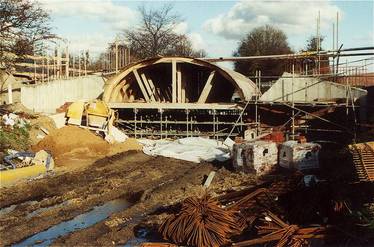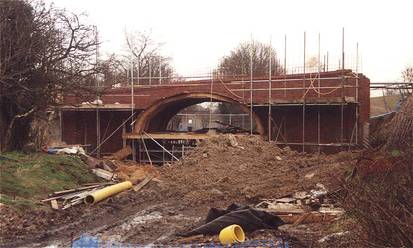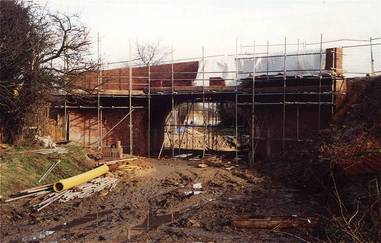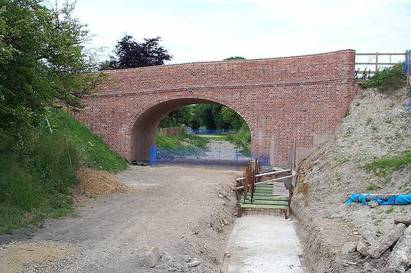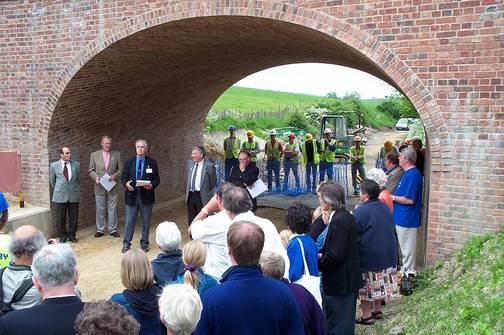The Original Bridge
This page describes the History of a bridge at Little Tring, which was an early major problem for the restoration of the Wendover Canal. The picture right shows the original Little Tring Bridge in the 1960s. The original bridge was built circa 1797 to a design by William Jessop, chief engineer for Grand Junction Canal Company, in brown brick with a red brick arch and blue brick band to the base of the parapet. It was a single track road bridge with the towpath passing under the bridge on the right as one passed towards Wendover. This bridge was not a Listed Structure.
Little Tring Road travels north-north-east, downhill from Tring having crossed the Upper Icknield Way. The road crosses over the canal at a slightly downward angle, then turns to the right and descends sharply through Little Tring before rising steeply on its way north towards Wilstone and the Lower Icknield Way.
The old bridge was humped and only one vehicle wide, while the embankment was flatter and wide enough for two vehicles.
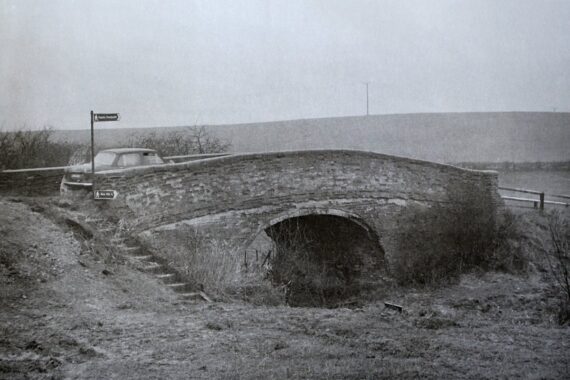
History of Little Tring Bridge – Early 1970
On March 5th, 1970, the Bucks Herald wrote: “Tring Council is concerned about the poor condition of Little Tring bridge which passes over the dried up canal. There is a temporary weight restriction on the bridge, and the council was of the opinion that it should be demolished and the road constructed on a solid foundation.”
However at a meeting of the Public Works Committee the Surveyor, Mr T W Jones, reported that he had received a letter from Bridge Engineer, British Waterways Board, Leeds, that arrangements were in hand for the replacement of the bridge. An effort would be made to commence work as soon as possible.
“In my reply I have again enquired why a bridge which spans an abandoned canal which has been dry for the past 50 years cannot be demolished and dispensed with” stated Mr Jones. He felt the bridge did not need replacing and stood by the council’s idea of demolition, levelling off and road widening. One of the benefits of this would be better visibility at the spot. If a new bridge were provided it should have sufficient width and should not dangerous.
Another newspaper reported that the bridge over the dry expanse of canal at Little Tring has deteriorated to such an extent that it cannot be strengthened. It must either be reconstructed or demolished; members of Tring Urban Council’s Public Works Committee were told. The committee had discussed this bridge at a previous meeting and it had been generally accepted then that demolition was the answer to the problem. Surveyor, Mr Thomas Jones, was instructed to write to British Waterways asking for a meeting about the future of the bridge. On Monday he told members that he had not received a reply to this request – only an acknowledgement.
History of Little Tring Bridge – Late 1970
Little Tring Bridge was discussed at a meeting at Hertford on November 13. The Board had no money to strengthen the bridges to the required standard. The Ministry therefore agreed that it would undertake the strengthening – but all other expenditure involved in the work had to be undertaken by the Highway Authority concerned. Mr. Jones said that it needs either reconstruction or demolition – “and the financial responsibility in respect of this work has yet to be determined.” Whichever way is decided, the work would be done within the next two years.
Mr. Jones also told members that he had received two letters objecting to the demolition of the bridge. One was from the Chairman of Beacon Village Society, who felt that if the weight restriction, which exists at the moment, were made permanent, moderate repair of the bridge would suffice and it could be retained “as a pleasant reminder of the past.” He felt too that the “staggered and stepped hamlet” of Little Tring is unusual and worthy of conservation.
The other letter came from the Water Resources Committee of the Chiltern Society – which hopes to see the Wendover Canal as a future linear Country Park with the canal being used by pleasure craft. “The Society is therefore anxious that their scheme should not be jeopardised by the demolition of the bridge,” said Mr. Jones.”
Committee members were, however, more concerned with the dangers of the bridge, and the cost of reconstructing it. Councillor Ralph Seymour said it should be demolished – the cost of reconstructing it would be too much – “unless they have between £2,000 and £3,000 to spend.” Councillor Bob Hedges agreed – “We are in the motor age, we must think of the motorist,” he said. The committee as a whole agreed, and recommended demolition.
History of Little Tring Bridge – Demolition
The following, from Grand Union Canal Society’s committee meeting minutes, gives a further insight into the demise of the bridge, as follows :- The minutes of 17th December 1971 stated that the bridge is to be demolished. In March 1972 BWB assured GUCS that the bridge would be retained. However because of the importance of retaining the bridge hole a letter was sent to Sir Frank Price (Chairman of BWB) asking for confirmation of this. A reply was received in May 1972 stating that negotiations with the local council had agreed that moorings would be provided at Tring so that an embankment could be built in place of the bridge. This was all subject to planning permission.
Planning permission for the embankment was granted in August 1972. Although GUCS tried to obtain a copy of what was planned BWB declined to co-operate. The Inland Waterways Association took up the fight in October 1972 but Sir Frank Price replied saying regrettably the Wendover Arm would be cut off by the embankment.
By March 1973 the embankment [replacing the bridge] was finished but various GUCS members observed that the bridge hole had only been filled in and the abutments still existed. The road had not been realigned and a two ton weight limit was still in force.
2000-1 Rebuilt by the Trust
On Wednesday 21st June 2000 the Trust Council voted unanimously to pay for the rebuilding of Little Tring Bridge. This would not just be a modern concrete slab, but an arched bridge with brick facing, to demonstrate the values and intent of the Trust.
On 24th July 2000 the road was officially closed for the construction work to begin. The initial task was to place the various site huts on the dry bed of the canal and fence off the site for safety reasons. Next, trial pits were dug to reveal the line of the various services. The gas pipe was found to be closer to the works than previously thought, and in a potentially dangerous position. However, thanks to a prompt and very welcome decision by TRANSCO, the pipes were diverted at no cost to the Trust.
On 27th May 2001 the new bridge was officially opened marking a major milestone in the restoration of the canal.
